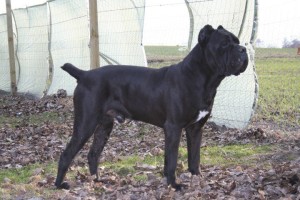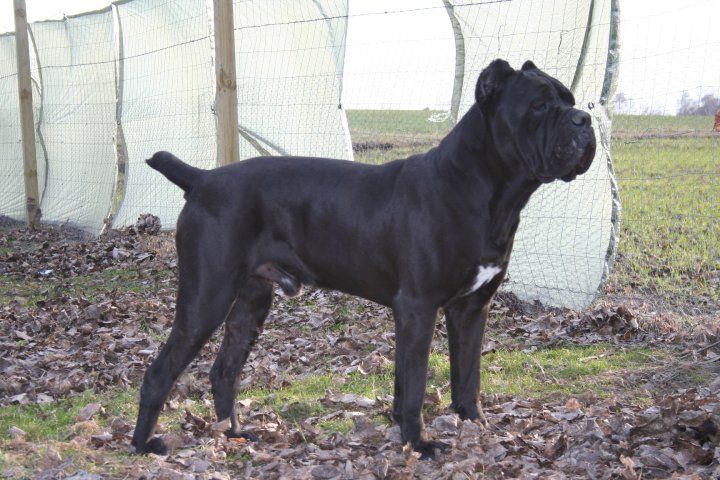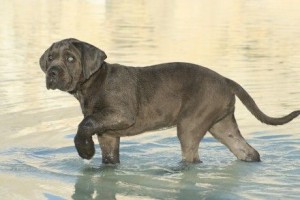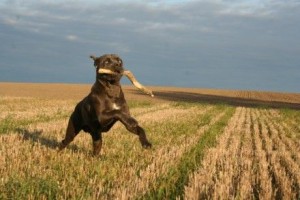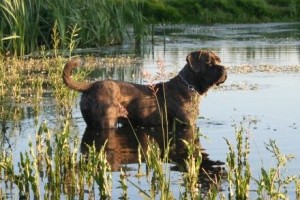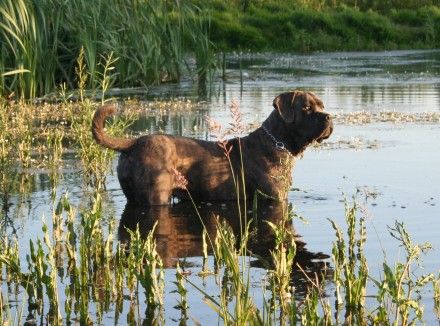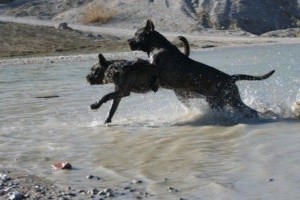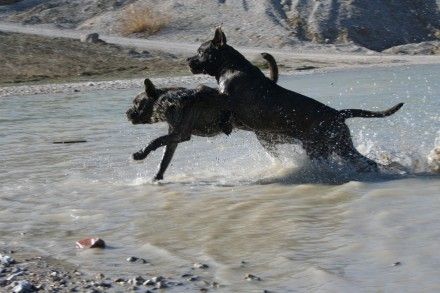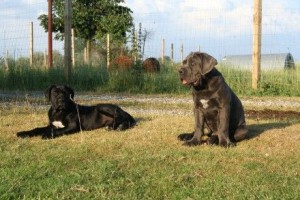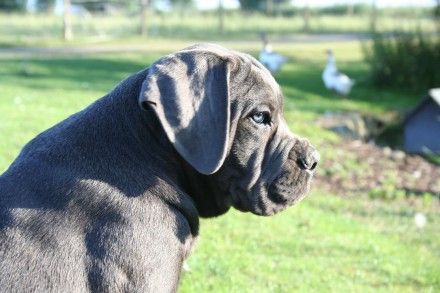Cane Corso Italiano

 This is a classic Italian bulldogge/mastiff, descended from the old Roman Molossers, closely associated with the southern Puglia region and related to the Neapolitan, as well as the Sicilian breeds, with which it has traditionally been classified together under the Cane da Presa name. It also has ties with the Alano Espanol and other European working breeds of the Alaunt type. Contrary to popular belief, this is not a re-creation of the Sicilian Branchiero, nor there ever was a "Cane di Macellaio" breed.
This is a classic Italian bulldogge/mastiff, descended from the old Roman Molossers, closely associated with the southern Puglia region and related to the Neapolitan, as well as the Sicilian breeds, with which it has traditionally been classified together under the Cane da Presa name. It also has ties with the Alano Espanol and other European working breeds of the Alaunt type. Contrary to popular belief, this is not a re-creation of the Sicilian Branchiero, nor there ever was a "Cane di Macellaio" breed.
While not quite the same breed as the original Cane Guzzo of Sicily, today's Cane Corso (pronounced Kah-Neh Kor-Soh) is a revived continuation of the old Cane Corso, period. The still-alive Branchiero Siciliano, along with a few more Sicilian breeds is related to the Cane Corso, and they all at one time or another went under the name of Cane di Macellaio, referring to their butchershop guarding job, not a specific breed. It should also be clarified that this is NOT a Corsican breed, as some ill-informed breeders and fanciers seem to think. Perpetuating this myth only creates even more confusion, which is the last thing this magnificent Molosser needs.
Unlike some of its Sicilian cousins, the Cane Corso was originally a hunting dog, a very fast large game tracker. It was only later that it became a cattle drover and a personal guardian. And eventually it found its way into the arenas as a baiter of bears, bulls and giant cats of Africa and Asia. It didn't take long before it became a popular fighting dog, which is what it unfortunately stayed mostly remembered as in the West, even though it's neither bred for it nor is that its original role.

 The present-day Cane Corso exists in decent numbers, but because of reckless breeding and crosses with some bull-breeds, it is getting difficult to find a true representative of the breed. Although the initial efforts were focused on preserving the original farm dogs from Puglia and surrounding areas, a fair amount of English Bullmastiff and German Boxer blood was introduced in the early years of the revival programme to help expand the Cane Corso gene pool, but the use of these breeds unfortunately resulted in the appearance of certain physical traits which weren't associated with the Cane Corso Italiano in the past, creating some controversy concerning the proper breed type.
The present-day Cane Corso exists in decent numbers, but because of reckless breeding and crosses with some bull-breeds, it is getting difficult to find a true representative of the breed. Although the initial efforts were focused on preserving the original farm dogs from Puglia and surrounding areas, a fair amount of English Bullmastiff and German Boxer blood was introduced in the early years of the revival programme to help expand the Cane Corso gene pool, but the use of these breeds unfortunately resulted in the appearance of certain physical traits which weren't associated with the Cane Corso Italiano in the past, creating some controversy concerning the proper breed type.
Because not all stock came from the same places and not every person involved in the revival programme shared the same vision, the breed was led in different directions. While Vito Indiveri and Paolo Breber are credited as the leading forces in the salvation of the breed, the influence of other, lesser known participants shouldn't be ignored, even if they've been less than honest about their breeding practices, which oftentimes relied on the employment of somewhat questionable outcrosses. The dogs found in the rural areas were one thing, but examples found closer to the cities and oftentimes from fighting bloodlines were something altogether different. Regardless of the romantic interpretations of the Cane Corso history, it should be clear to everyone that the modern incarnation of the breed was established on the foundation stock that numbered both the old and isolated strains of true farm workers, as well as the examples whose origin is neither ancient nor pure.

 Sadly, a great number of modern Italian examples can be seen with uncharacteristic head shapes and overly short muzzles, thanks to the widely accepted, yet strongly denied, excessive use of Boxer blood in Corso breedings in recent years. However, there is a number of Corso fanciers in Italy who are breeding for a specific type, which they believe to be pure and historically correct, commonly referred to as the Cane Corso Ortognato. The unrelated breed known as the American Corso Dog is a modern creation, developed in the United States by crossing the Neapolitan Mastiff with the Rottweiler and various Bandogges. Even though this American breed is oftentimes presented as the Cane Corso, it has no real ties with the Italian breed.
Sadly, a great number of modern Italian examples can be seen with uncharacteristic head shapes and overly short muzzles, thanks to the widely accepted, yet strongly denied, excessive use of Boxer blood in Corso breedings in recent years. However, there is a number of Corso fanciers in Italy who are breeding for a specific type, which they believe to be pure and historically correct, commonly referred to as the Cane Corso Ortognato. The unrelated breed known as the American Corso Dog is a modern creation, developed in the United States by crossing the Neapolitan Mastiff with the Rottweiler and various Bandogges. Even though this American breed is oftentimes presented as the Cane Corso, it has no real ties with the Italian breed.
Most American and Canadian fanciers of the Cane Corso Mastiff regularly import dogs from Italy and are committed to the preservation and promotion of the true type and purity of the breed, but some western lines have been enriched with the blood of other working dogs, namely the Presa Canario, American Pit Bull Terrier, Neapolitan Mastiff, Bullmastiff, Rottweiler, Boxer and the aforementioned American Corso Dog, resulting in a great variety within the breed in the United States, bluring the lines between the American-bred Cane Corso Italiano and the American Corso Dog breeds even more. The Canadian Cane Corso is currently known as the Corso Pugliese, but unlike the American Corso Dog, this isn't a designer breed at all, but a specific Puglia type of the Cane Corso Mastiff, with the Ortognato stock directly descended from Italy. The Corso Pugliese name is in place to easier distinguish Canadian dogs from the official Cane Corso Italiano, but also from the American Corso Dog.

 It should also be noted that not every light mastiff that resembles a Corso really is a true Cane Corso Italiano as recognized internationally, because this is not the only Italian breed of this type. Even in Italy, there is a number of unpure strains to be encountered, but there are also a few indigenous separate breeds which share the early ancestry of the Cane Corso. The above-mentioned Cane da Presa population of Italy also consists of other breeds, such as the Dogo Sardo, Cane da Branco, Bucciriscu Calabrese, Sicilian Vucciriscu and others, including certain strains of old Maltese Mastiffs believed to had survived in southern Sicily through assimilation into the indigenous Cane Guzzo population.
It should also be noted that not every light mastiff that resembles a Corso really is a true Cane Corso Italiano as recognized internationally, because this is not the only Italian breed of this type. Even in Italy, there is a number of unpure strains to be encountered, but there are also a few indigenous separate breeds which share the early ancestry of the Cane Corso. The above-mentioned Cane da Presa population of Italy also consists of other breeds, such as the Dogo Sardo, Cane da Branco, Bucciriscu Calabrese, Sicilian Vucciriscu and others, including certain strains of old Maltese Mastiffs believed to had survived in southern Sicily through assimilation into the indigenous Cane Guzzo population.
So, even if a dog is imported from Italy, it doesn't necessarily mean that it is a real Cane Corso Italiano, or at least not the recognized variety. Matings between the other types and the modern Cane Corso were common ever since the 1970's, almost exclusively at the expense of those other breeds, most of which are on their way to extinction. A number of fanciers don't differentiate between these breeds, claiming that they are simply regional varieties of the Cane Corso, which is certainly not completely true. However, some enthusiasts believe that using indigenous varieties of the Cane da Presa Italiano population as outcrosses for the Cane Corso genepool is much better than relying on Boxer or Bullmastiff blood. Apart from the varieties already listed, there is also a moderately popular working breed known as the Mezzocorso, which was developed by crossing the Cane Corso with the Abruzzese Mastiff and although it is a very different dog which can't really be confused with the Cane Corso Italiano in any way, this fact doesn't prevent some people to falsely report the Cane della Murgia as its subtype.
 If bred properly, the Italian Cane Corso Mastiff is of sound temperament, easily trained and a breed which makes an excellent family dog. Very affectionate towards children, it will gladly give up its life to protect them. This breed is completely devoted to only one master and very loving of its human family, but is naturally aloof with strangers. Although not as dominant as the American variant, the Cane Corso Italiano is still fairly dog-aggressive and at times overly protective, so it needs experienced and responsible handling. This is a very athletic and fast dog, possessing great agility and stamina, requiring a reasonable amount of exercise and more importantly, it needs a job. The body is muscular, with a straight back and long sturdy legs. This powerful Molosser has a deep and wide chest, with a strong neck and an elegant broad head and muzzle. The tail is docked and the ears are usually cropped, but unaltered specimens can be found as well.
If bred properly, the Italian Cane Corso Mastiff is of sound temperament, easily trained and a breed which makes an excellent family dog. Very affectionate towards children, it will gladly give up its life to protect them. This breed is completely devoted to only one master and very loving of its human family, but is naturally aloof with strangers. Although not as dominant as the American variant, the Cane Corso Italiano is still fairly dog-aggressive and at times overly protective, so it needs experienced and responsible handling. This is a very athletic and fast dog, possessing great agility and stamina, requiring a reasonable amount of exercise and more importantly, it needs a job. The body is muscular, with a straight back and long sturdy legs. This powerful Molosser has a deep and wide chest, with a strong neck and an elegant broad head and muzzle. The tail is docked and the ears are usually cropped, but unaltered specimens can be found as well.
While some modern dogs have very short and smooth Bandog-like coats, the traditional coat type for the breed is short, flat, but also hard and quite thick, as well as densely undercoated, coming in a variety of solid colours, with black, silver, blue and brindle being the most appreciated and currently favoured over the traditional fawn, chestnut, red and brown shades. White markings can still be encountered today, mostly on the chest and feet, but aren't preferred, even though dogs with white markings on the head and body existed in the past, not to mention that piebald and even uniform white examples were also quite common before the standardization of the breed. Although black-n-tan dogs do exist, as they have for a long time, they're not accepted by the Standard, as they're seen as a sign of recent Rottweiler influence, thanks to the American Corso controversy.
With present-day Corsi being overall larger than their ancestors, the average height proposed for the breed should be around 26 inches, but there are even taller dogs to be found today.
-
The Story Early news
he first spark to revive the interest in the Cane Corso was a letter written by Pablo Petrelli and published in 1978 in the ENCI1 Official Gazette, number 6: ‘I Nostri Cani’ In December that year, in ‘I Nostri Cani’ there was an article by Paul Breber which described the subject found in La Puglia, also thanks to the description found in a letter by Professor Bonatti on December 2, 1973. In that letter a short-haired dog was described, different from the Neapolitan Mastiff, added Professor Ballotta, famous Schnauzer breeder who had seen several in the rural areas of La Puglia. In May 1979, Stefano Gandolfi who was barely sixteen realizes, thanks to Breber’s writings and pictures, that this old Italian breed has survived two World Wars. This discovery and the idea of the genetic recovery of the breed became his main goal. He involved in his project Giancarlo and Luciano Malavasi, renown German Shepherd breeders, sharing with them all the passion and burning enthusiasm that encouraged him. The three of them got in touch with Breber who spared no efforts in order to give them all the information he had and expressed his wish to go with them to La Puglia and to the places where he had found the first specimens and where the first couple had been put together, heading thus towards the recovery of the breed (On 14/11/75 from ALIOT, grey and MIRAK, striped, 7 puppies were born. Amongst them was the striped female BRINA who with PICCIUT, striped, give birth to 10 puppies on the 15/01/78). On September 1979, Pablo Breber, Stefano Gandolfi, and Luciano Malavasi met in La Puglia in order to locate and choose the first subjects with which to select the breed and start the recovery. First approximations During the first visit to La Puglia, from Mantova, the attention of the three enthusiasts (Breber, Gandolfi, and Malavasi) revolved around six specimens, 2 males and 4 females born in the 1975 and 1978 litters, all of them size medium to large, with mesomorph constitution and developedmusculature. The specimens were all noble, athletic, and fierce, very satisfactory in their molosoide structure, with, however, an absolute absence of the excessive heaviness of the Neapolitan Mastiff and totally different from it. These specimens were very similar in structure and could be differentiated in two types when examining the head. ALMA and COCAB, born in ’78 from BRINA, had the alaneggiante head and the scissor teeth. The mother, however, had a shorter muzzle and an inverted scissor bite. TIPSI, another of the females, again daughter of BRINA, was described by Gandalfi thus: “she had a long face, a little over one third of the length of the head with a group of teeth closed in inverted scissor. The head, as a whole, was noble and proportioned, a short and harmonious female, alert, fierce and lively. A key female in the breed recovery programme”. To these four females the male TAPPO, also a son of BRINA, was added. Slightly prognate, with a highly respectable musculature, tawny coloured, it was
going to be given as a gift to some friends of Breber in Foggia. They completed the six specimens by adding PICCIUT, the striped male, father of ALMA, COCAB, TIPSI, and TAPPO. The owner, Armando Gentile, said about the son that he presented an even more typical head, with a muzzle that amounted, as in the case of the daughter TIPSI, to a little more than one third of the head. All these dogs had slightly convergent craniofacial axes in common. The recovery The specific difficulty for the recovery of the breed arose in this first transfer: there were many of them and there was some reluctance on the side of the owners to whom the specimens born of the first litter produced by Breber had been entrusted who utterly lacked any cynophile culture.
-
Gandolfi said that “heterogeneity, numeric inconsistency and the difficulties of making our recovery programme understood were causes for concern, even of utter confusion. In September 1980, only 5 of the 17 puppies born of Breber’s first two litters could be located. The others, donated to shepherds, were scattered around the countryside and their track had been lost. Only two females, TIPSI and BRINA, were under direct control. Other located specimens were the male DAUNO – brother of BRINA – and the very old MIRAK.
Essentially, it was only a pebble in the pond, the real recovery of the breed had not yet begun.” Aware of the situation and the difficulties, Gandolfi and the Malavasi brothers realize, with Casolino’s advice, that in order to start a serious recovery programme they lacked “a venue that guaranteed appropriate attention for the future development and, above all, a pragmatic selection philosophy.”
The Malavasi brothers take care of all of this and commit to granting the use of their kennel to accommodate the most commendable specimens; they “take care of them, supervise the couplings, help females with deliveries and monitor the litters. All in return for a future, waiting for the hypothetical results on a breed unknown to the majority of people and of uncertain fate.”
(Casolino) Thanks to the availability of the Malavasi brothers it was finally possible to start the serious programme of recovery that had been in their thoughts and in the thoughts of Gandolfi and Casolino. These people, with determination and perseverance, laid the foundations of what today is the Italian Cane Corso, transferring between the end of 1979 and January 1980 the first three specimens in Mantova: the females TIPSI and BRINA together with DAUNO, a black male born from Breber’s first litter from MIRAK x ALIOT.
Results of the first selection Despite the difficulties, working in consanguinity with the aim of fixing the type and structure characteristics, from these three specimens the first examples of Cane Corso of the modern age were born. Amongst them appeared, due to the quality of their figure, structure, and capacity to transmit genetic features, some specimens which are the origin of all modern specimens: firstly, above all, two black brothers, sons of DAUNO x TIPSI, born in Malavasi and la Battaglia’s kennel, currently ‘Antico Cerberus’. BASIR, lent to Casolino and considered as the zootechnic point of reference for the breed; BULAN, owned by Gianantonio Sereni, proved to be an excellent breeder in the breed recovery programme; and, entrusted by the Malavasi brothers to Michele Angiolillo: ALIOT, gray male, and BABAK, tabby female.
The rebirth “The 18th of October, 1983, was a historical day for the Cane Corso. For the first time, a group of enthusiasts gathered with their dogs to assess the situation.
-
The 12 adult specimens have been examined and accurately measured by Dr. Giovanni Ventura, vet, breeder and judge for the ENCI. Almost all subjects had a slight prognathism, the cranio-facial axes were slightly convergent; the average weight was 47 kg for males and 38 kg for females. The coat was mainly black, tabby, tawny, and gray. All the dogs had an athletic appearance and no weight excess, a square and massive head.” (Gandolfi) On that same day the ‘Società Amatori Cane Corso’ headquartered at Mantova, became official. President: Stefano Gandolfi. Vice-presidents: Pablo Breber and Luciano Malavasi. Secretary: Fernando Casolino. Treasurer: Giancarlo Malavasi. Director: Gianantonio Sereni. Founders: M. Angiolillo - N. Anselmi - D. Baldassarri - G. Bonatti - C. Bondavalli - B. Bonfanti - P. Breber - P. Buzzi - F. Casolino - G. Gallini - S. Gandolfi - G. Malavasi - L. Malavasi - G. Mauro - G. Monfardini - S. Nardi - G. Sereni - V. Suffritto - A. Tellini - G. Ventura. In 1985 Casolino was assigned to keep in touch with the cynophile judges and with the ‘Ente Nacionale della Cinofilia Italiana’ so as to obtain the official recognition of the breed. They all engaged in a campaign of activism and conviction with the future new members of the association and the most popular judges within the ENCI. BASIR, initiator and undisputed breeder, “had been confidentially introduced to several judges who considered him as a model in terms of morphology, behaviour and character.”
-
(Gandolfi) On the 16th of June, 1985, the first formal meeting of SACC enthusiasts and official cynephilia, as represented by the ENCI judges Franco Bonetti, Antonio Morsiani, Mario Perricones and Claudio Bussadori, was held.
Ten Cane Corsi were presented and despite the scarcity of dogs, the ENCI was highly interested, so that on the 3rd of November, 1985, an official delegation was sent to Mantova, to the ‘Raduno di Razza’ organized by the SACC. Judges Barbati, Mentasti, Morsiani, Pinturas, Perricone, Vandoni, and Ventura attended as representatives. After this ENCI meeting, the possibility of an official recognition of the breed started being considered; undoubtedly, because of the constant interest shown by Antonio Morsiani and Mario Perricone, expert and renown judges and breeders of Molosoides.
In 1986, Casolino, Malavasi, and Sereni Gandolfi go to the south several times in search of new specimens to be introduced within the bloodline they had selected. Within a year and a half, thanks to the collaboration of the new enthusiast cynophiles living in areas of La Puglia, Umbria, and Sicily, they manage to acquire almost 30 new specimens, belonging to eleven different bloodlines. During this year and a half, thanks to these new members, a delegation of the SACC was created in La Puglia and Sicily, thus starting a fruitful collaboration between the enthusiasts of the original areas of the Cane Corso and the centre of selection and rebirth of the breed, which was in Mantova, at the Malavasi brothers’ kennel.
The main responsible of this collaboration, the link between the south and the selection centre in Mantova, was the enthusiast Vito Indivieri. He was a friend of Morsiani, resident in La Puglia, and he strove to catalogue and find the most commendable specimens while he travelled as a peddler. In Sicily, the same commitment and passion were carried out by Giovanni Tumminello who offered enough historical information and photographic documents to take a census in this area, the Cane Corso still present and typical.
Thanks to this unity of spirit the task of recovery that had started at the end of 1979 was carried out; this enabled Dr. Morsiani to start the biometric measurements that would rapidly lead to the drafting of the official standard of the Italian Cane Corso. Dr. Morsiani, who was within the ENCI Judges Committee, the SACC Committee, companion and assistant in the several meetings between the North and the South of Gandolfi, Malavasi, Indiveri, and Tuminello, started carrying out the cynotechnic measurements, choosing BASIR as the breed prototype and selecting 50 specimens amongst the 90 dogs that were judged.
The recognition of the breed After long journeys, successes and disappointments, doubts and certainties, after the cynotechnic measurements, the cynometric studies and character assessments, after more than seven years of hard work and passion, finally arrives the first official recognition for the Italian Cane Corso: on November, 1987, The ENCI Executive Board approves the standard established by Dr. Antonio Morsiani. In 1988, during the canine exhibition of Milan, Florence, and Bari, the judges Morsiani, Perricone, and Vandoni carried out assessments of another 50 dogs and the results of the measurements to which were added almost 60 specimens registered and censed by Vito Indivieri on the south of Italy, including photographs and detailed information about the different bloodlines.
At the end of 1988 the topographic map of the known and registered specimens was complete. A last general exam was carried out in Foggi in October with the presence of Morsiani for all the necessary assessments. This last successful exam finally convinced the ENCI experts on taking the last necessary steps for the final and official recognition of the breed. On the occasion of the European Exhibition at Verona on the 25th of November, 1990, fifteen Cane Corsi paraded in the ring of honour.
This was the first official presentation to the international Cynophilia; at that moment, an Open Book was created and given to Professor Vittorio Dagradi where all the adult specimens were registered; after having undergone the cynometric result and the recognition tattoo, these would be considered in accordance to the standard elaborated by Antonio Morsiani based on the morphological prototype of BASIR.
“In Seveso, at the end of September, 1993, the Cane Corso passes the test that establishes its title with the presence of judges Bernini, Bonetti, and Vandoni – almost a hundred Cane Corsi under the sky of Lombardy! The ENCI ( Ente Nacionale della Cinofilia Italiana. ) Executive Board consulted the other filed registers and after hearing the favourable opinion of the Judges Committee, the Italian Breed Committee, and the Breeding Committee, welcomed the recognition on the 20th of January, 1994: the Cane Corso rightfully became the Italian number 14.

